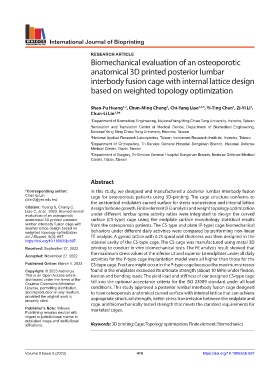Page 418 - IJB-9-3
P. 418
International Journal of Bioprinting
RESEARCH ARTICLE
Biomechanical evaluation of an osteoporotic
anatomical 3D printed posterior lumbar
interbody fusion cage with internal lattice design
based on weighted topology optimization
3
1,2
1
Shao-Fu Huang , Chun-Ming Chang , Chi-Yang Liao 1,4,5 , Yi-Ting Chan , Zi-Yi Li ,
1
Chun-Li Lin *
1,2
1 Department of Biomedical Engineering, National Yang Ming Chiao Tung University, Hsinchu, Taiwan
2 Innovation and Translation Center of Medical Device, Department of Biomedical Engineering,
National Yang Ming Chiao Tung University, Hsinchu, Taiwan
3 National Applied Research Laboratories, Taiwan Instrument Research Institute, Hsinchu, Taiwan
4 Department of Orthopedics, Tri-Service General Hospital Songshan Branch, National Defense
Medical Center, Taipei, Taiwan
5 Department of Surgery, Tri-Service General Hospital Songshan Branch, National Defense Medical
Center, Taipei, Taiwan
Abstract
*Corresponding author: In this study, we designed and manufactured a posterior lumbar interbody fusion
Chun-Li Lin cage for osteoporosis patients using 3D-printing. The cage structure conforms to
(cllin2@ym.edu.tw)
the anatomical endplate’s curved surface for stress transmission and internal lattice
Citation: Huang S, Chang C, design for bone growth. Finite element (FE) analysis and weight topology optimization
Liao C, et al., 2023, Biomechanical
evaluation of an osteoporotic under different lumbar spine activity ratios were integrated to design the curved
anatomical 3D printed posterior surface (CS-type) cage using the endplate surface morphology statistical results
lumbar interbody fusion cage with from the osteoporosis patients. The CS-type and plate (P-type) cage biomechanical
internal lattice design based on
weighted topology optimization. behaviors under different daily activities were compared by performing non-linear
Int J Bioprint, 9(3): 697. FE analysis. A gyroid lattice with 0.25 spiral wall thickness was then designed in the
https://doi.org/10.18063/ijb.697 internal cavity of the CS-type cage. The CS-cage was manufactured using metal 3D
Received: September 27, 2022 printing to conduct in vitro biomechanical tests. The FE analysis result showed that
the maximum stress values at the inferior L3 and superior L4 endplates under all daily
Accepted: November 27, 2022
activities for the P-type cage implantation model were all higher than those for the
Published Online: March 1, 2023 CS-type cage. Fracture might occur in the P-type cage because the maximum stresses
Copyright: © 2023 Author(s). found in the endplates exceeded its ultimate strength (about 10 MPa) under flexion,
This is an Open Access article torsion and bending loads. The yield load and stiffness of our designed CS-type cage
distributed under the terms of the fall into the optional acceptance criteria for the ISO 23089 standard under all load
Creative Commons Attribution
License, permitting distribution, conditions. This study approved a posterior lumbar interbody fusion cage designed
and reproduction in any medium, to have osteoporosis anatomical curved surface with internal lattice that can achieve
provided the original work is appropriate structural strength, better stress transmission between the endplate and
properly cited.
cage, and biomechanically tested strength that meets the standard requirements for
Publisher’s Note: Whioce marketed cages.
Publishing remains neutral with
regard to jurisdictional claims in
published maps and institutional
affiliations. Keywords: 3D printing; Cage; Topology optimization; Finite element; Biomechanics
Volume 9 Issue 3 (2023) 410 https://doi.org/10.18063/ijb.697

